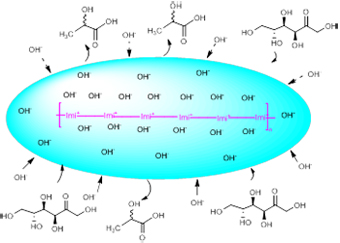| [1] Keshwani, D. R.; Cheng, J. J. Bioresour. Technol. 2009, 100(4), 1515.
[2] Sims, R. E. H.; Mabee, W.; Saddler, J. N.; Taylor, M. Bioresour. Technol. 2010, 101(6), 1570.
[3] Rom, L. Y.; Barrettc, J.; Liu, Z. Y. Nat. Biotechnol. 2007, 447, 982.
[4] Chang, C. Ph.D. Dissertation, Institute of Bioengineering, Zhejiang University, Hangzhou, 2006 (in Chinese). (常春, 博士论文, 浙江大学生物工程研究所, 杭州, 2006.)
[5] Zhu, G.-Y.; Ma, Y.-H.; Zhu, X. Chin. J. Org. Chem. 2010, 30, 142 (in Chinese). (朱广用, 马艳华, 朱宪, 有机化学, 2010, 30, 142.)
[6] Huber, G. W.; Iborra, S.; Corma, A. Chem. Rev. 2006, 106, 4044.
[7] Demirbas, M. F.; Balat, M. Energy Convers. Manage. 2006, 47(15~16), 2371.
[8] Gallezot, P. Chem. Soc. Rev. 2012, 41, 1538.
[9] Chandel, A. K.; da Silva, S. S.; Carvalho, W.; Singh, O. V. J. Chem. Technol. Biotechnol. 2012, 87(1), 11.
[10] Liu, Z. Ph.D. Dissertation, Zhejiang University, Hangzhou, 2012 (in Chinese). (刘镇, 博士论文, 浙江大学, 杭州, 2012.)
[11] San-Martin, M.; Pazos, C.; Coca, J. J. Chem. Technol. Biotechnol. 1992, 54, 1e6.
[12] Epane, G.; Laguerre, J. C.; Wadouachi, A.; Marek, D. Green Chem. 2010, 12(3), 502.
[13] Gao, C.; Ma, C.; Xu, P. Biotechnol. Adv. 2011, 29(6), 930.
[14] Bai, D.; Zhao, X.; Li, X.; Xu, S. Biochem. Eng. J. 2004, 18(1), 41.
[15] Salminen, S.; Ouwehand, A.; Wright, A. V.; Daly, C. Ann. N. Y. Acad. Sci. 1993, 429.
[16] Zeng, W.; Chen, F.-Q.; Zhan, X.-L; Chem. Ind. Eng. Progr. 2006, 25(7), 744 (in Chinese). (曾炜, 陈丰秋, 詹晓力, 化工进展 2006, 25(7), 744.)
[17] Wasewar, K. L.; Yawalkar, A. A.; Moulijn, J. A.; Pangarkar, V. G. Ind. Eng., Chem. Res. 2004, 43(19), 5969.
[18] Aida, T. M.; Tajima, K.; Watanabe, M.; Saito, Y.; Kuroda, K.; Nonaka, T.; Hattori, H.; Smith, R. L.; Arai, K. J. Supercrit. Fluids 2007, 42(1s), 110.
[19] Onda, A.; Ochi, T.; Kajiyoshi, K.; Yanagisawa, K. Catal. Commol.2008, 9(6), 1050.
[20] Onda, A.; Ochi, T.; Kajiyoshi, K.; Yanagisawa, K. Appl. Catal. A 2008, 343(1~2), 49.
[21] Yan, X.-Y.; Jin, F.-M.; Tohji, K.; Kishita, A.; Enomoto, H. AIChE J. 2010, 56, 2727.
[22] Zhang, S.-P.; Jin, F. -M.; Hu, J.-J.; Huo, Z.-B. Bioresour. Technol. 2010, 102(2011), 1998.
[23] Rasrendra, C. B.; Makertihartha, I.; Adisasmito, S.; Heeres, H. J. Top. Catal. 2010, 53(15~18), 1241.
[24] Hayashi, Y.; Sasaki, Y. Chem. Commol/Lun. 2005, 41(21), 2716。
[25] Holm, M. S.; Saravanamurugan, S.; Taarning, E. Science 2010, 328, 602.
[26] Chambon, F.; Rataboul, F.; Pinel, C.; Cabiac, A.; Guillon, E.; Essayem, N. Appl. Catal. B 2011, 105, 171.
[27] (a) Aslanov, L. A.; Zakharov, V. N.; Savilov, S. V. RU 2471709, 2013 [Chenm. Abstr. 2013, 158, 162458].
(b) Patil, A. B.; Pathak, P.; Shinde, V. S.; Godbole, S. V.; Mohahapatra, P. K. Dalton Trans. 2013, 42(5), 1519.
(c) Luo, S.-Z.; Mi, X.-L.; Zhang, L.; Liu, S.; Xu, H.; Cheng, J.-P. Tetrahedron 2007, 1923.
[28] Song, Y.-L.; Wang, X.-C.; Huang, C.-P.; Liang, F.-B.; Chen, B.-H. Chin. J. Org. Chem. 2013, 33, 1715 (in Chinese). (宋彦磊, 王新承, 黄崇品, 梁凤兵, 毓志超, 陈标华, 有机化学, 2013, 33, 1715.)
[29] Gao, Y.-J. M.S. Thesis, Zhejiang Normal University, Jinhua, 2009 (in Chinese). (高尤剑, 硕士论文, 浙江师范大学, 金华, 2009.)
[30] Wei, Z.-Z. M.S. Thesis, Shandong University, Jinan, 2012 (in Chinese). (韦珍珍, 硕士论文, 山东大学, 济南, 2012.)
[31] Li, J.; Sun, H.; Cai, X.-C.; Dai, L.-Y. Chin. J. Org. Chem. 2007, 27, 1296 (in Chinese). (李娟, 孙辉, 蔡晓晨, 戴立益, 有机化学, 2007, 27, 1296.)
[32] Hirao, M.; Ito, K.; Ohno, H. Electrochim. Acta 2000, 45, 1291.
[33] Shaplov, A. S.; Lozinskaya, E. I.; Ponkratov, D. O.; Malyshkina, I. A.; Vidal, F.; Aubert, P. H.; Okatova, O. V.; Pavlov, G. M.; Komarova, L. I.; Wandrey, C.; Vygodskii, Y. S. Electrochim. Acta 2011, 57, 74.
[34] Ohno, H.; Ito, K. Chem. Lett. 1998, 27, 751.
[35] Hirao, M.; Ito, K.; Ohno, H. Polym. Adv. Technol. 2000, 11, 534.
[36] Zhang, H.; Zhou, Z. -B.; Nie, J. Prog. Chem. 2013, 25(5), 761 (in Chinese). (张恒, 周志彬, 聂进, 化学进展, 2013, 25(5), 761.)
[37] He, H.-Y.; Zhang, S.-J.; Liu, X.-M.; Wang, J.-W.; Yao, X.-Q.; Zhang, X.-P. Fluid Phase Equilib. 2013, 169.
[38] Yan, R.-Y.; Yang, P.; Li, Z.-X.; Wang, H.; Diao, Y.-Y.; Wang, L.; Zhang, S.-J. Adv. Mater. Res. 2011, 1146.
[39] Dong, K.; Song, Y.-T.; Liu, X.-M.; Cheng, W.-G.; Yao, X. -Q.; Zhang, S.-J. J. Phys. Chem. B 2011, 1007.
[40] Kanazawa, A.; Ikeda, T.; Endo, T. J. Polym. Sci., Part A: Polym. Chem. 1993, 31, 1099.
[41] Bicker, M.; Endres, S.; Ott, L.; Vogel, H. Mol. J. Catal. A: Chem.2005, 239, 151.
[42] Ellis, A. V.; Wilson, M. A. J. Org. Chem. 2002, 67, 8469.
[43] Rasrendra, C. B.; Fachri, B. A.; Makertihartha, I. G. B. N.; Adisasmito, S.; Heeres, H. J. ChemSusChem 2011, 4, 768. |
